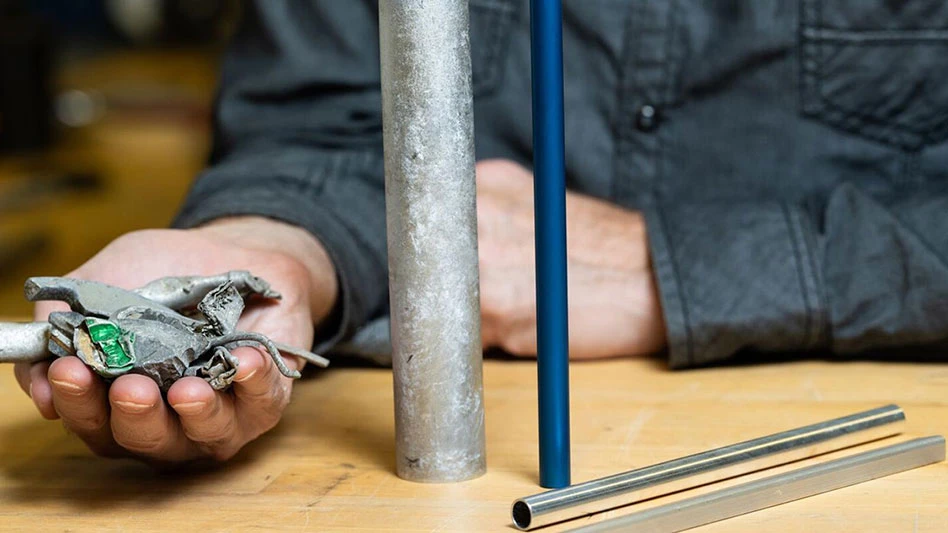
Photo courtsey of PNNL
Earlier this year, deep-tech entrepreneur Eric Donsky formed Atomic13, a joint venture partnership with one of the largest scrap metal companies in North America, to industrialize the Shear Assisted Processing and Extrusion, or ShAPE, process under development at the U.S. Department of Energy’s (DOE’s) Pacific Northwest National Laboratory (PNNL) in Richland, Washington. The process can transform billets made from postconsumer aluminum into low-carbon extruded parts.
ShAPE leverages the combination of shear and axial forces to refine the grain structure of aluminum, unlocking the possibility of using 100 percent postconsumer scrap as the sole feedstock for the manufacturing of high-performance aluminum extrusions and significantly lowering the carbon emissions associated with the use of primary aluminum.
RELATED: PNNL's ShAPE enters next generation
Atomic13 initially is focused on delivering a catalog of extruded components for applications in building and construction (B&C), an industry that comprises roughly 57 percent of the $100 billion global aluminum extrusion market and is under increasing regulatory pressure to decarbonize, he says.
Donsky has extensive experience commercializing deep-tech innovations. He was the founding CEO of Bioamber, one of the first industrial synthetic biology companies combining genome editing and precision fermentation to manufacture bulk chemicals and polymers from carbohydrates instead of petrochemicals.
Four national labs, including PNNL, developed several proprietary process technologies that were exclusively licensed to Bioamber for commercialization. The company eventually went public on the New York Stock Exchange at a $1.4 billion valuation, he notes. Donsky later founded TearLab Corp., one of the earliest laboratory-on-a-chip diagnostic companies that grew into a $500 million NASDAQ listed company.
Remodeling the aluminum microstructure
While the aluminum extrusion industry is working to decarbonize its products by increasing the recovered aluminum content in its billet compositions, extruders could need to add about 25 percent to 50 percent primary aluminum to their melts to dilute the impurities in the microstructure to attain the properties for a given alloy chemistry, he says. Consequently, aluminum extrusions can have a high carbon footprint.
Primary aluminum production results in significant carbon dioxide emissions, averaging 16 kilograms of CO2 for each kilogram produced, he says, so adding primary aluminum to the casting process increases the embodied carbon of extruded products. By contrast, roughly 2 kilograms of CO2 are emitted per kilogram of steel produced.
The most significant challenge to broadening the use of scrap aluminum in billet compositions and extrusions is impurities, Donsky says, which typically are agglomerations of second-phase metallics, such as silicon, iron, manganese, magnesium and copper, contained in the scrap that adversely affect the structural and functional properties of extrusions.
ShAPE addresses the impurities in aluminum scrap through the use of rotational shear force.
“This is an atomic-scale remodeling of the aluminum microstructure in a fraction of a second right as we do extrusion," Donsky says.
ShAPE uses rotation to create friction on the billet’s microstructure to obliterate the second phases, which he notes mitigates the risks of higher corrosion potential, poor cosmetic properties and microfracturing of the material.
Thousands of extrusions already have been made using ShAPE and the properties meet or exceed the ASTM standards for the corresponding alloy chemistry, Donsky says, adding, "It’s an exciting opportunity to unlock the possibility of using twitch scrap as a raw material for manufacturing high-performance extrusions."
The path to commercialization
Atomic13 has an ongoing partnership with PNNL and plans to continue research and development activities.
“The focus over the next 24 months is to develop a novel scrap-based alloy chemistry for the B&C industry that can deliver extrusions with similar or better properties than 6063 alloy," Donsky says. "We plan on delivering extruded parts to customers for evaluation over the next year. The B&C industry is ready for the decarbonization of key building materials, and Atomic13 is very well-positioned to become integral to the planning and construction of buildings with a low-carbon profile.”
Donsky says the company is forming partnerships with leading architecture and engineering firms that influence the buying decisions of Atomic13’s end customers.
“The business model is to build ShAPE extrusion at scale, build our own cast houses and be vertically integrated with our scrap partner that can certify all the scrap delivered to our plant gate as 100 percent post-consumer,” he says. “And to sell extrusions to the building and construction industry and eventually to other market segments where decarbonization drives the buying decision.
“We realized early on that we needed to partner with a major scrap metal company in order to integrate our supply chains and deliver products of high quality. We were fortunate to secure a partnership with a company that shares our vision and has the capacity to deliver scrap supplies for factories nationwide.”
Atomic13 plans to build its first factory with sizable capacity for casting and extrusion, to the tune of tens of thousands of tons of scrap and extrusions, eventually incorporating finishing. That facility can serve as the model for additional plants going forward. Atomic13 is eyeing several possible locations for its first manufacturing facility.
Atomic13’s goal is to improve the competitiveness of the U.S. aluminum extrusion industry, with Donsky noting the dumping of products produced outside the country into the U.S. market.
“If we can build extrusions with a 90 percent lower carbon footprint from 100 percent postconsumer scrap and offer our products on price parity, that is going to give the U.S. market more resilience against foreign intrusion if you will, like low-cost, dumped subsidized product," he says.
Latest from Recycling Today
- BMW Group, Encory launch 'direct recycling’ of batteries
- Loom Carbon, RTI International partner to scale textile recycling technology
- Goodwill Industries of West Michigan, American Glass Mosaics partner to divert glass from landfill
- CARI forms federal advocacy partnership
- Monthly packaging papers shipments down in November
- STEEL Act aims to enhance trade enforcement to prevent dumping of steel in the US
- San Francisco schools introduce compostable lunch trays
- Aduro graduates from Shell GameChanger program





